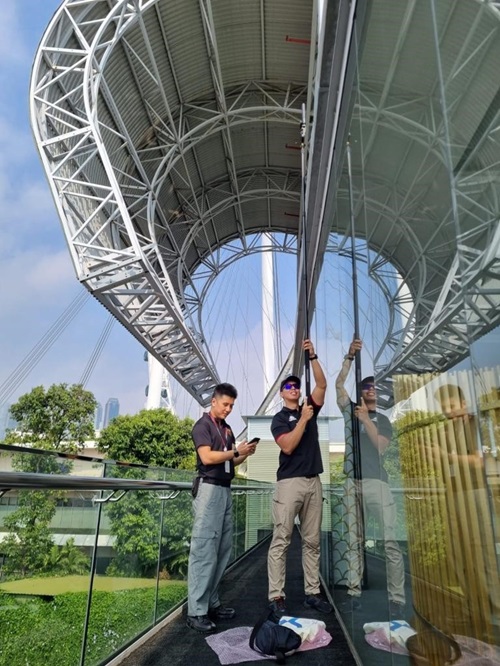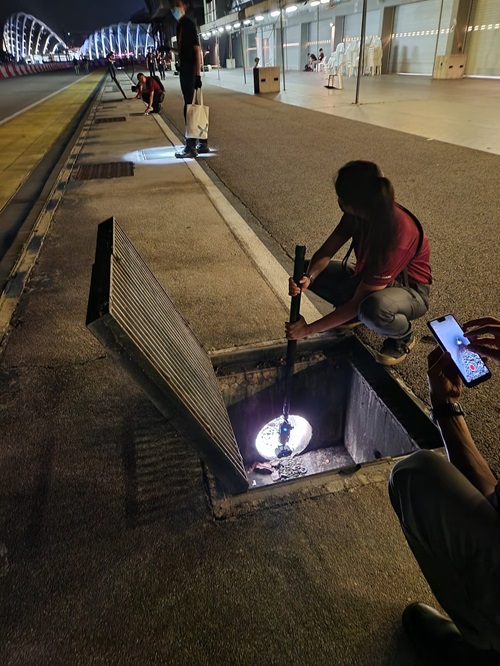 Inspecting the ceiling with the Q-Stick (Photo: SPF)
Inspecting the ceiling with the Q-Stick (Photo: SPF)
Innovations often involve over-the-top gadgets or mechanisms. In contrast, HTX’s Q-Stick team tackled its operational users’ challenge with a simple solution that is multi-functional, modular, configurable, and built using off-the-shelf accessories. Here is how the team came up with their multiple award-winning solution.
The Q-Stick project aimed to solve the difficulty that operations officers face in searching for incriminating items or abnormalities at inaccessible areas before major security events. These areas range from high nooks to enclosed spaces or narrow crevices, which are often poorly lit.
Instead of searching for a one-size-fits-all solution, the Q-Stick team chose to improvise and they developed the Q-Stick, which aims to enhance the safety and efficiency of the Police Security Command’s (SecCom’s) search operations. The team
was inspired by a tool improvised by a security officer which used conventional search mirrors to improve the range of view and illumination in enclosed areas. This gave rise to the idea of the Q-Stick which in simple terms is a camera on a stick.
 Checking a drain with the Q-Stick (Photo: SPF)
Checking a drain with the Q-Stick (Photo: SPF)
While a stick may not sound glamorous or high-tech, it has two significant advantages. First, the Q-Stick enables the search operator to check enclosed spaces such as false ceilings and drains for any incriminating items or abnormalities. Second, by minimising the need to deploy costly equipment for manual search operations, it enhances operational efficiency and cost effectiveness.
Innovation through rapid prototyping exemplified the Q-Stick’s development. The initial prototype of the Q-Stick consisted of a mini-camera attached to a pole. As the original mini-camera had sub-par resolution, the team trialled many other cameras before settling on one which had satisfactory resolution and provided an improved field of view for the officers.
The Q-Stick was refined over several operational trials, which the engineers partook in. They observed and empathised with the operational users' pain points and eventually developed a suitable prototype. Innovation is a continuous process, and the Q-Stick engineers are currently working on further enhancements to enable the operational users to safely access areas with false ceiling panels.
 Inspecting the ceiling with the Q-Stick (Photo: HTX)
Inspecting the ceiling with the Q-Stick (Photo: HTX)
Today, the Q-Stick is a modular device which can be quickly reconfigured with the required components by search operators to give them clear views of the specific areas they are searching. Armed with the Q-Stick, search operators will be able to minimise the use of ladders or boom lifts to inspect false ceilings. The device will also reduce the need to climb into sewage tunnels to check for incriminating items. It has improved the operational efficiency of the Home Team and the Q-Stick team is exploring other use cases for the device.
 Q-Stick team receiving Most Innovative Pitch Award from CE (Photo: HTX)
Q-Stick team receiving Most Innovative Pitch Award from CE (Photo: HTX)
The Q-Stick team is led by Melvin Lim, Deputy Director (Q2), Q Team, and consists of Ng Gee Wah, Director, Q Team, and Lau Yan Ling, Lum Sam Heng, Yeo Kiat Nern, and Hansel Tay, all of whom are engineers with Q2, Q Team. The team also has members from the SPF: Winston Yim, the Commanding Officer of one of the units in the Police Security Command, and Personal Security Officers Yusri, Paul Tan, and Goh Meng Kwang. The team won the eXemplary Innovator (Team) Award at the HTX Awards 2023, as well as the Most Innovative Award at the HTX Convention Pitch Day event.
This project also won the 2024 Home Team InnovA Dare-To-Try award.

